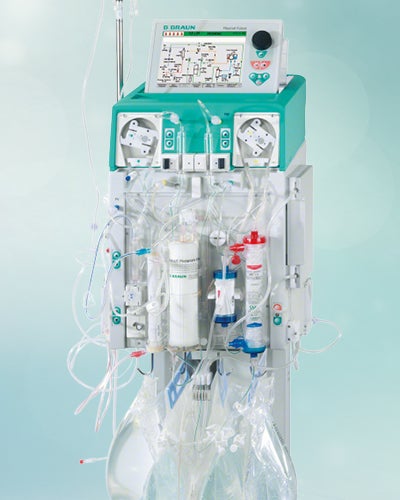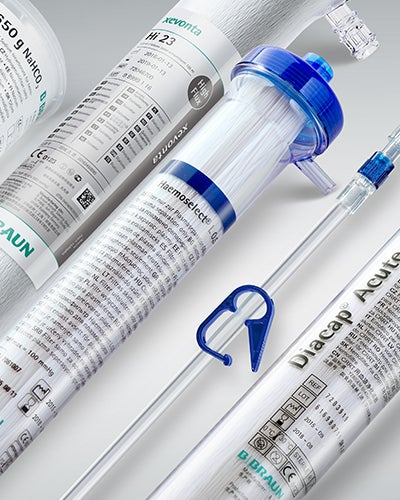Apheresis Safety for high-risk patients
Choose a category or subcategory
30 years of experience in apheresis treatment
From a global perspective more than 3000 patients are treated with apheresis every year. In this context HELP apheresis is a well established therapy with more than 30 years of experience and over 470,000 treatments worldwide. HELP is a highly selective kind of therapy. Atherosclerotically effective risk factors such as lipoprotein (a), fibrinogen, and inflammatory factors are being removed additionally apart from LDL cholesterol.
Apheresis treatment
What is Apheresis?
Apheresis essentially means a separation of plasma from the rest of the blood. Therapeutic Apheresis (therapeutic plasmapheresis, lipoprotein Apheresis, immune Apheresis) removes pathogenic substances from blood in treatment for chronic metabolic diseases which cannot or only inadequately be treated with medication. This therapy acts only on symptoms and mitigates their harmful effects.
Therapeutic Apheresis
The until now worldwide most common performed procedure is therapeutic plasmapheresis in which the separated plasma is discarded and substituted by an albumin solution. It is performed mostly in cases of auto-immune illnesses (e.g. rheumatoid arthritis) and sepsis (blood poisoning), but is not suitable for long-term chronic treatments because of the loss of a broad range of plasma proteins. An appropriate procedure of therapeutic Apheresis to perform chronic treatments is the lipoprotein Apheresis which removes lipoproteins (blood lipids such as LDL cholesterol) directly from the blood or plasma in the treatment of cardiovascular diseases. Lipoprotein Apheresis is differentiated between semi-selective and selective lipoprotein Apheresis. In the case of semi-selective lipoprotein Apheresis (cascade or double filtration), the plasma proteins are filtered out in a second step without differentiation between pathogens or desirable plasma constituents.
H.E.L.P. LDL Apheresis
Plasma-proteins and blood lipids can be adsorbed by an adsorber or precipitated from the plasma by means of modulation. Plasma modulation is better than plasma adsorption and full-blood adsorption in terms of compatibility with a patient's prescribed medicines. H.E.L.P. lipoprotein Apheresis is performed by way of plasma modulation. The abbreviation H.E.L.P. stands for
H eparin-induced
E xtracorporal
L ipoprotein/fibrinogen
P recipitation.
In a separation process, the plasma in the patient's blood is segregated from its blood cells. The separated plasma is mixed with an acetate buffer saturated with heparin. This lowers the plasma's degree of acidity (pH value) to 5.12, causing the LDL cholesterol, Lp(a) and fibrinogen to drop selectively out of the plasma. Together with the heparin additive, the plasma lipoproteins form insoluble precipitates which can be removed from the plasma in a single filtration stage. Unused surplus heparin is held back in a separate adsorber, and bicarbonate ultrafiltration is used to restore the purified plasma to the physiologically acceptable level. The selectively treated, purified plasma is then remixed with the remaining blood constituents and supplied back to the patient. During H.E.L.P. Apheresis, these four steps (plasma separation, precipitation with subsequent filtration, heparin adsorption and ultrafiltration) are performed by a single device, the PLASMAT Futura.
Cardiovascular disease
H.E.L.P. Apheresis is used mainly for patients with familial hypercholesterolemia resulting in cardiovascular disorders which are therapy refractory.
What are cardiovascular diseases?
In the broadest sense, cardiovascular diseases relate to the heart and blood circulation. Extremely diverse in nature, cardiovascular diseases can affect the coronary vessels (coronary illness), cardiac muscle (heart failure), cardiac valves (aortic valve insufficiency, aortic stenosis, etc.), cardiac rhythm (arrhythmia, fibrillation, etc.) or endocardium (infectious or rheumatic endocarditis).
What causes cardiovascular diseases?
Cardiovascular diseases have a host of causes affecting different parts of the cardiovascular system (blood vessels, heart). Blood vessel illnesses often involve arteriosclerotic diseases and associated risks such as hypercholesterolemia arterial hypertension, diabetes mellitus, smoking hazards, etc. The resultant arteriosclerosis can cause circulatory disorders in a variety of organs. Affected in particular are the heart (coronary disease with angina pectoris, heart attack), brain (stroke), lower extremities (peripheral arterial obstructive disease), or more rarely, the inner ear (disruptions in micro-circulation leading to acute hearing loss).
What are the potential consequences of cardiovascular disease?
The consequences of cardiovascular disease are very diverse. They can range, for instance, between high blood pressure, cardiac insufficiency, arrhythmia and heart attack, depending on which part of the cardiovascular system is affected. The consequences are usually attributable to arteriosclerotic alterations in the blood vessels (calcification). Arteriosclerosis involves an inflammatory alteration of the vessels' inner walls. Excessively high cholesterol level in patients with a cardiovascular condition is due to a genetic metabolic disorder of the liver. Excess cholesterol is deposited on the vessels' walls where it leads to a formation of plaque. If a stable plaque becomes unstable and ruptures, the affected organ - usually the heart - suffers an infarct.
Treatment of cardiovascular diseases
An LDL concentration of up to 160 mg/dl of blood is considered acceptable for healthy persons. For patients with a cardiovascular condition the recommended LDL concentration limit is 100 mg/dl (70 mg/dl for diabetic patients). If a patient cannot achieve a set target by altering their lifestyle, observing a diet and taking medication meant to lower blood lipid levels, the patient could be allowed to receive H.E.L.P. Apheresis after passing a strict assessment and approval procedure. H.E.L.P.









